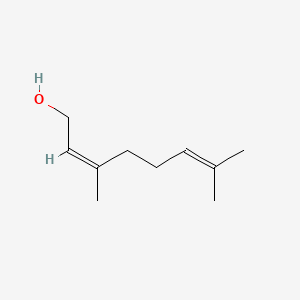| Authors | Title | Published | Journal | PubMed Link |
|---|---|---|---|---|
| Baffi MA et al. | A novel β-glucosidase from Sporidiobolus pararoseus: characterization and application in winemaking. | 2011 | J. Food Sci. | pmid:21819399 |
| Katsukawa M et al. | Citronellol and geraniol, components of rose oil, activate peroxisome proliferator-activated receptor α and γ and suppress cyclooxygenase-2 expression. | 2011 | Biosci. Biotechnol. Biochem. | pmid:21597168 |
| Michlmayr H et al. | Characterization of two distinct glycosyl hydrolase family 78 alpha-L-rhamnosidases from Pediococcus acidilactici. | 2011 | Appl. Environ. Microbiol. | pmid:21784921 |
| Zore GB et al. | Evaluation of anti-Candida potential of geranium oil constituents against clinical isolates of Candida albicans differentially sensitive to fluconazole: inhibition of growth, dimorphism and sensitization. | 2011 | Mycoses | pmid:20337938 |
| Polo MP et al. | Geraniol and simvastatin show a synergistic effect on a human hepatocarcinoma cell line. | 2011 | Cell Biochem. Funct. | pmid:21735455 |
| Swerdlin A et al. | Fragrance mix reactions and lime allergic contact dermatitis. | 2010 Jul-Aug | Dermatitis | pmid:20646673 |
| Gilpin S et al. | In vitro human skin penetration of geraniol and citronellol. | 2010 Jan-Feb | Dermatitis | pmid:20137738 |
| Reeves WK and Miller MM | Aqueous 2% geraniol as a mosquito repellent failed against Aedes aegypti on ponies. | 2010 | J. Am. Mosq. Control Assoc. | pmid:21033064 |
| Jassbi AR et al. | Phytotoxic volatiles in the roots and shoots of Artemisia tridentata as detected by headspace solid-phase microextraction and gas chromatographic-mass spectrometry analysis. | 2010 | J. Chem. Ecol. | pmid:21086024 |
| Parodi A et al. | A comparative study of leukaemia inhibitory factor and interleukin-1alpha intracellular content in a human keratinocyte cell line after exposure to cosmetic fragrances and sodium dodecyl sulphate. | 2010 | Toxicol. Lett. | pmid:19878710 |
Nerol
Nerol is a lipid of Prenol Lipids (PR) class. The involved functions are known as Odorant, Anabolism, Diastasis, Metabolic Inhibition and Oxidation. Nerol often locates in germ tube. The related lipids are Octanols, Pinene, Hexanols, ethyl butyrate and ethyl hexanoate.
Cross Reference
Introduction
To understand associated biological information of Nerol, we collected biological information of abnormalities, associated pathways, cellular/molecular locations, biological functions, related genes/proteins, lipids and common seen animal/experimental models with organized paragraphs from literatures.
What diseases are associated with Nerol?
There are no associated biomedical information in the current reference collection.
No disease MeSH terms mapped to the current reference collection.
PubChem Associated disorders and diseases
What pathways are associated with Nerol
There are no associated biomedical information in the current reference collection.
PubChem Biomolecular Interactions and Pathways
Link to PubChem Biomolecular Interactions and PathwaysWhat cellular locations are associated with Nerol?
Visualization in cellular structure
Associated locations are in red color. Not associated locations are in black.
Related references are published most in these journals:
| Location | Cross reference | Weighted score | Related literatures |
|---|
What functions are associated with Nerol?
Related references are published most in these journals:
| Function | Cross reference | Weighted score | Related literatures |
|---|
What lipids are associated with Nerol?
Related references are published most in these journals:
| Lipid concept | Cross reference | Weighted score | Related literatures |
|---|
What genes are associated with Nerol?
There are no associated biomedical information in the current reference collection.
What common seen animal models are associated with Nerol?
There are no associated biomedical information in the current reference collection.
